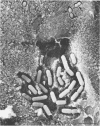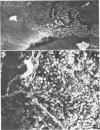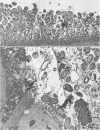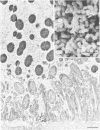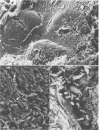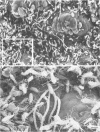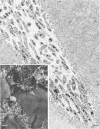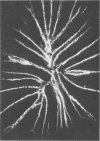Abstract
Incorporation of purified phytohemagglutinin (PHA) lectins derived from red kidney beans (Phaseolus vulgaris) in the diet of weanling rats will cause growth failure, malabsorption of nutrients, and bacterial overgrowth in the small intestine. These effects are not caused by feeding a similar quantity of PHA to germfree rats. To define the morphological and bacterial changes on the mucosal surfaces of the jejunum, ileum, and cecum in greater detail, we pair fed two groups of weanling rats isocaloric, isonitrogenous diets with or without 0.5% PHA protein. On the jejunal surfaces of control rats, the mucous layer was a confluent covering with sparsely scattered bacteria and protozoa. In PHA-treated rats, the mucous layer was thin and discontinuous, and the microvillous surface of the tissue was extensively populated by bacterial cells of two distinct morphotypes--a gram-negative rod and a gram-positive coccobacillus. In all PHA-treated animals, these bacteria formed adherent monospecific or mixed adherent microcolonies on the tissue surface. Tissue damage was observed in PHA-exposed jejunal tissue as evidenced by vesiculation of the microvillous plasma membrane and by damage to the brush border membrane. On the ileal surfaces of control rats, there was a thick mucous layer within which small numbers of bacteria and protozoa were seen. Segmented filamentous bacteria were anchored in the tissue surface. In PHA-treated rats, the ileal surface was only incompletely covered by a mucous layer, and the overlying mucosal surface was extensively covered by large numbers of protozoan cells (predominantly Hexamita muris). Most of the ileal surfaces not covered by the mucous layer were occupied and virtually occluded by an overgrowth of these protozoan cells with occasional cells of Giardia muris and the tissue-associated segmented bacillus. In the ceca of control rats, the mucosa was incompletely covered by a discontinuous mucous layer and colonized by an unnamed Spirillum sp., other bacteria, and occasional protozoa. The cecal surfaces of PHA-treated rats retained most of their incomplete overlying mucous layer, which was heavily colonized by the same type of Spirillum sp. seen in untreated animals; intestinal crypts were colonized. These descriptive morphological studies demonstrate that exposure to purified PHA in the diet caused characteristic changes in the microbial ecology of the small intestine. The changes in microbial flora contributed to the malabsorption of nutrients in the small intestines of PHA-fed animals.
Full text
PDF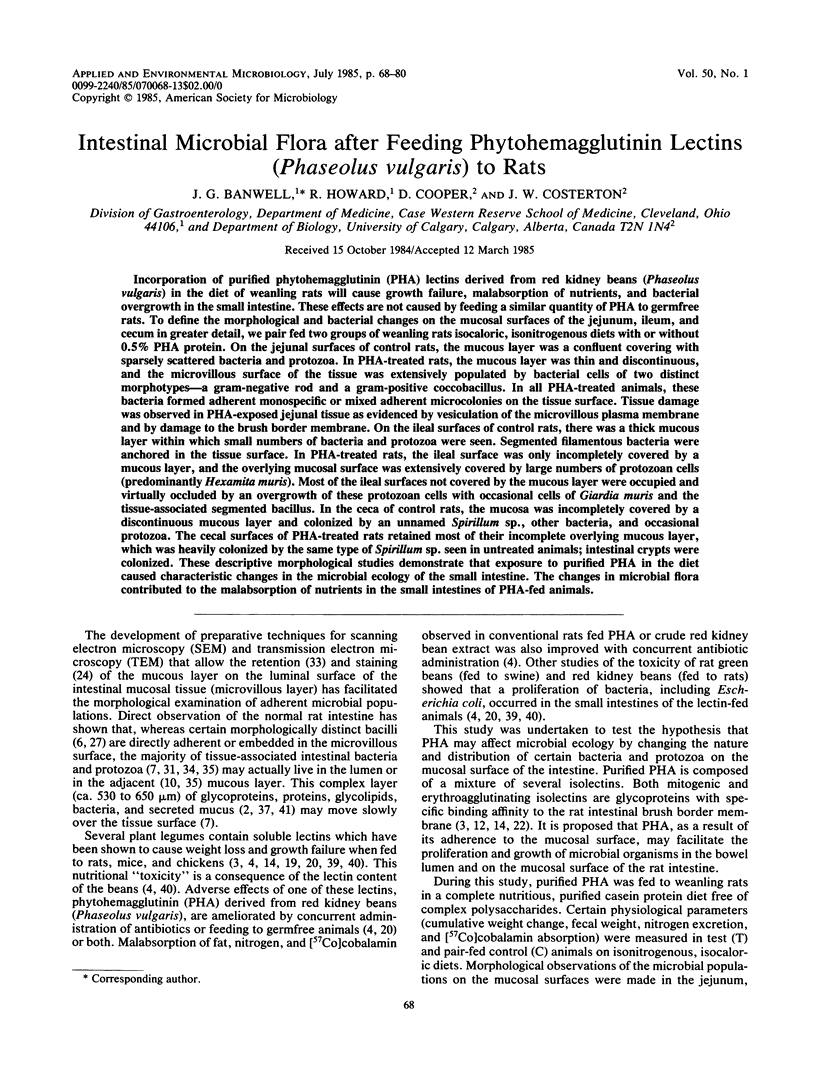
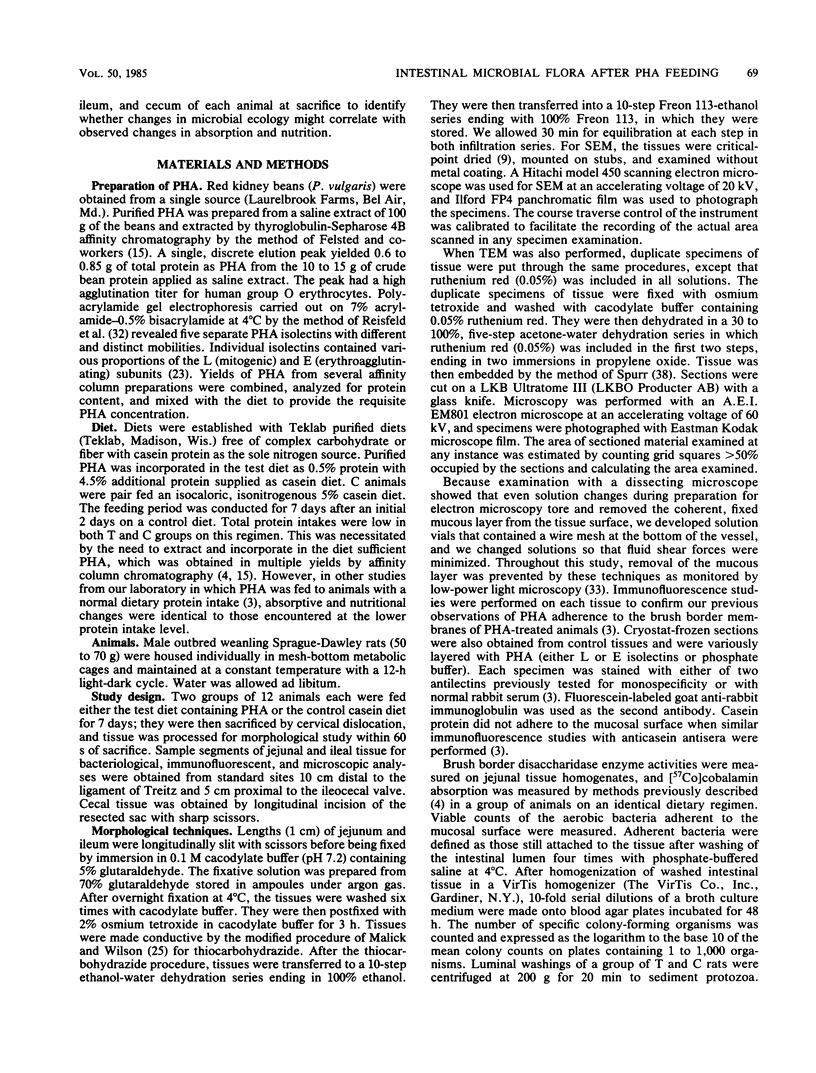
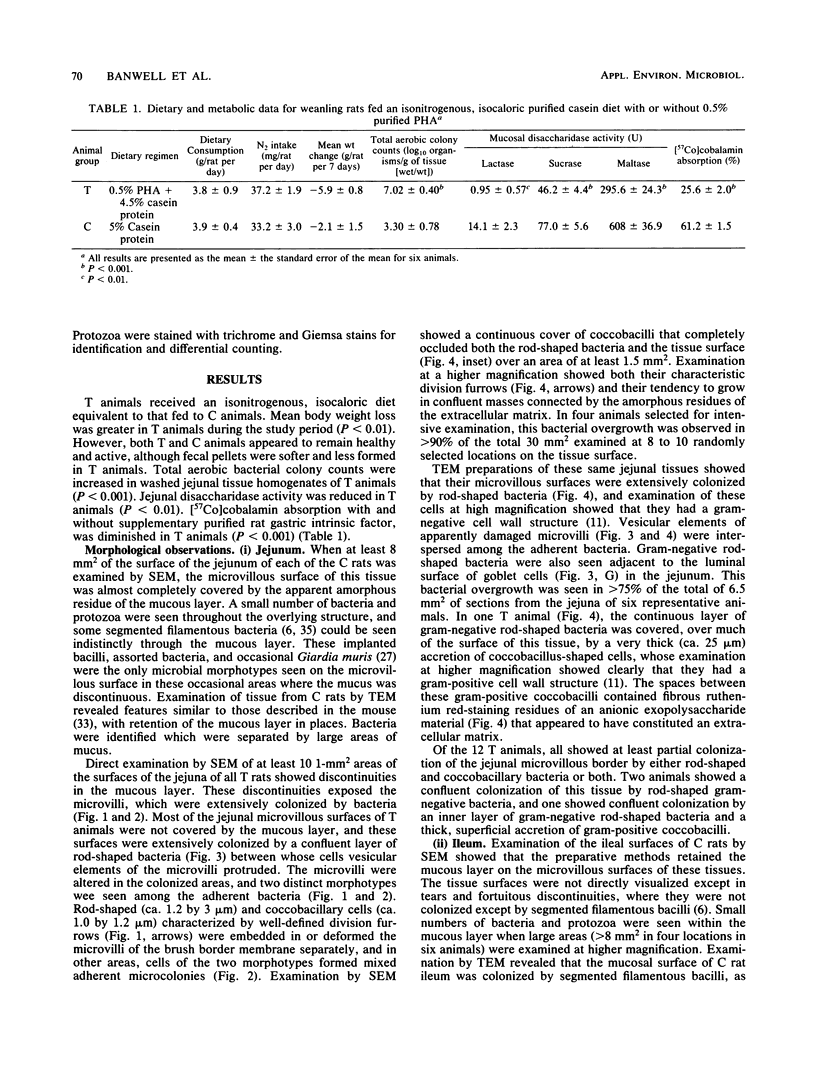
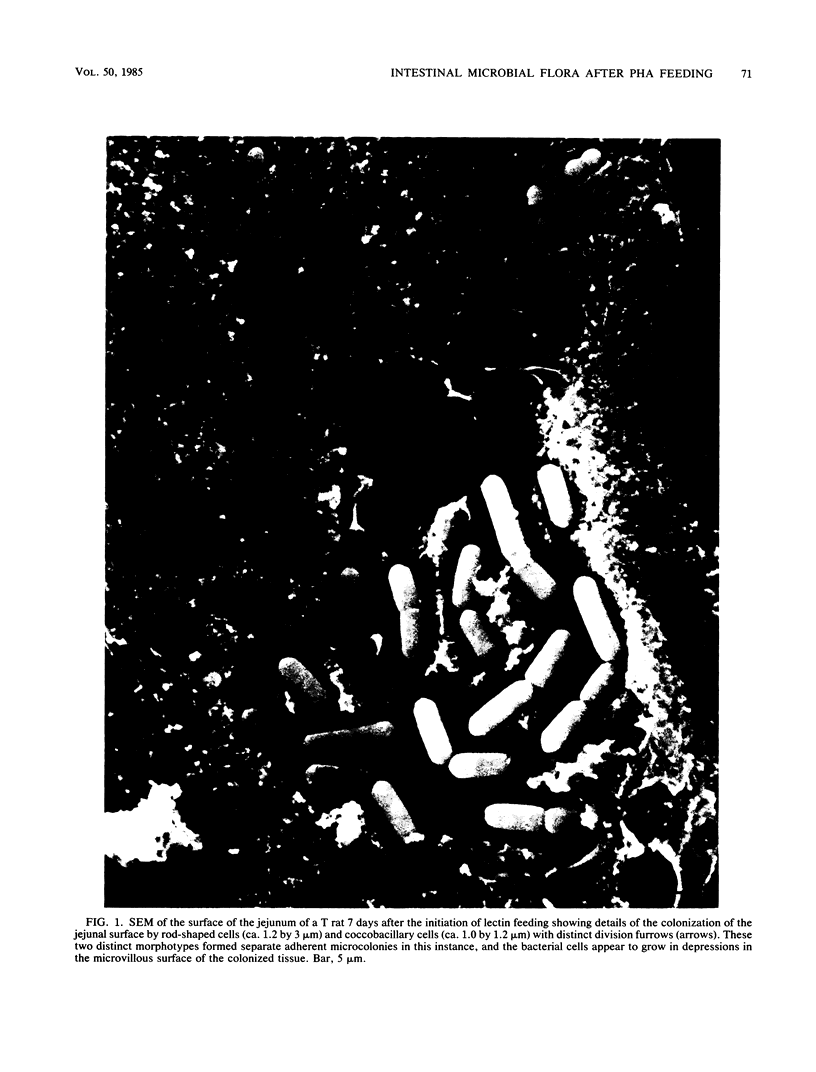
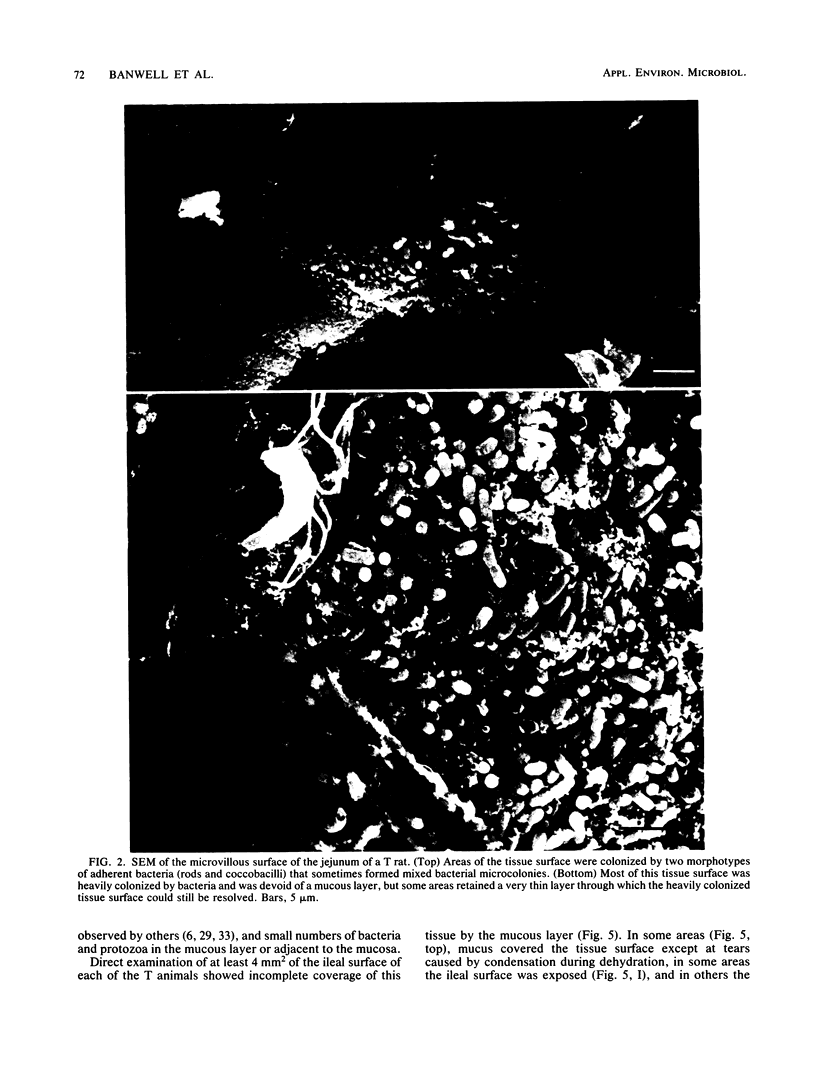
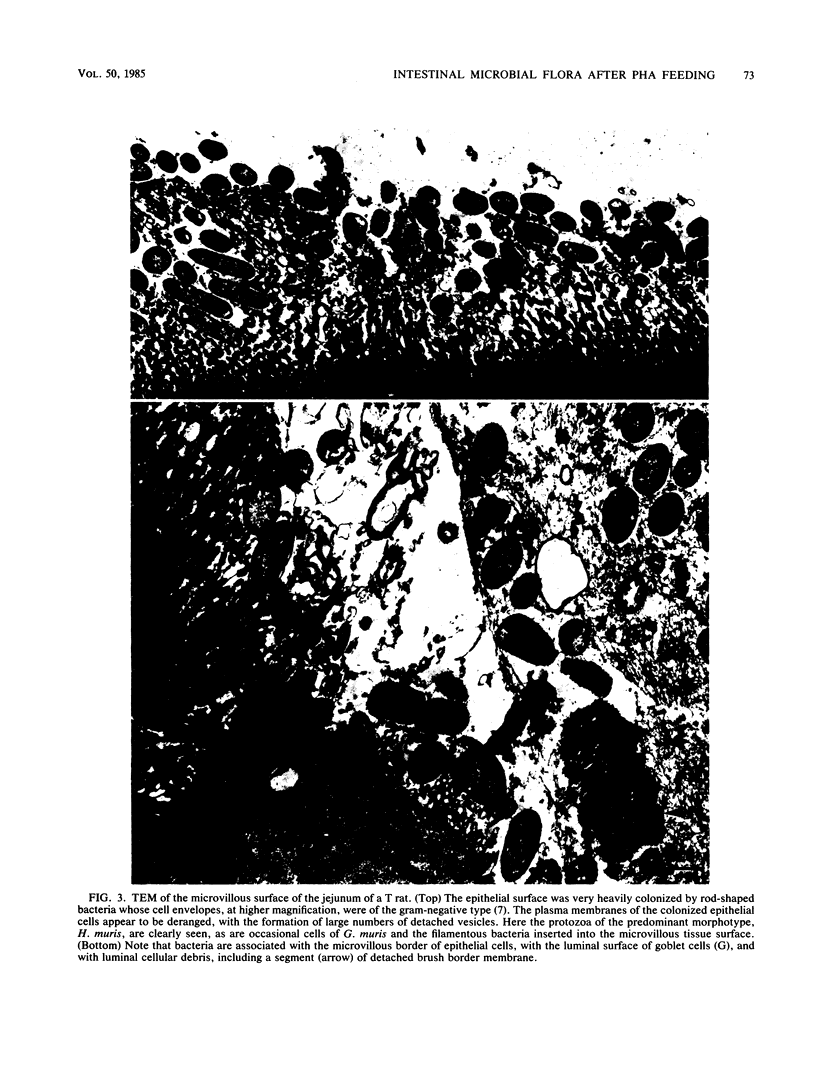
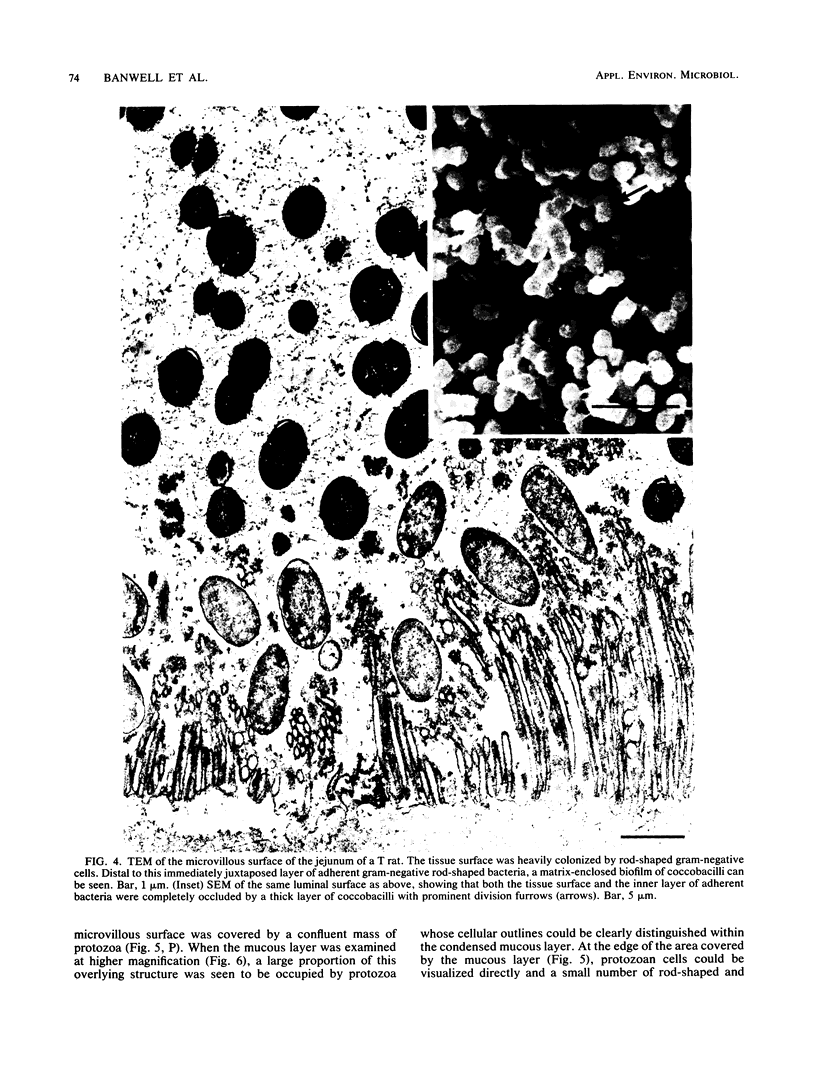
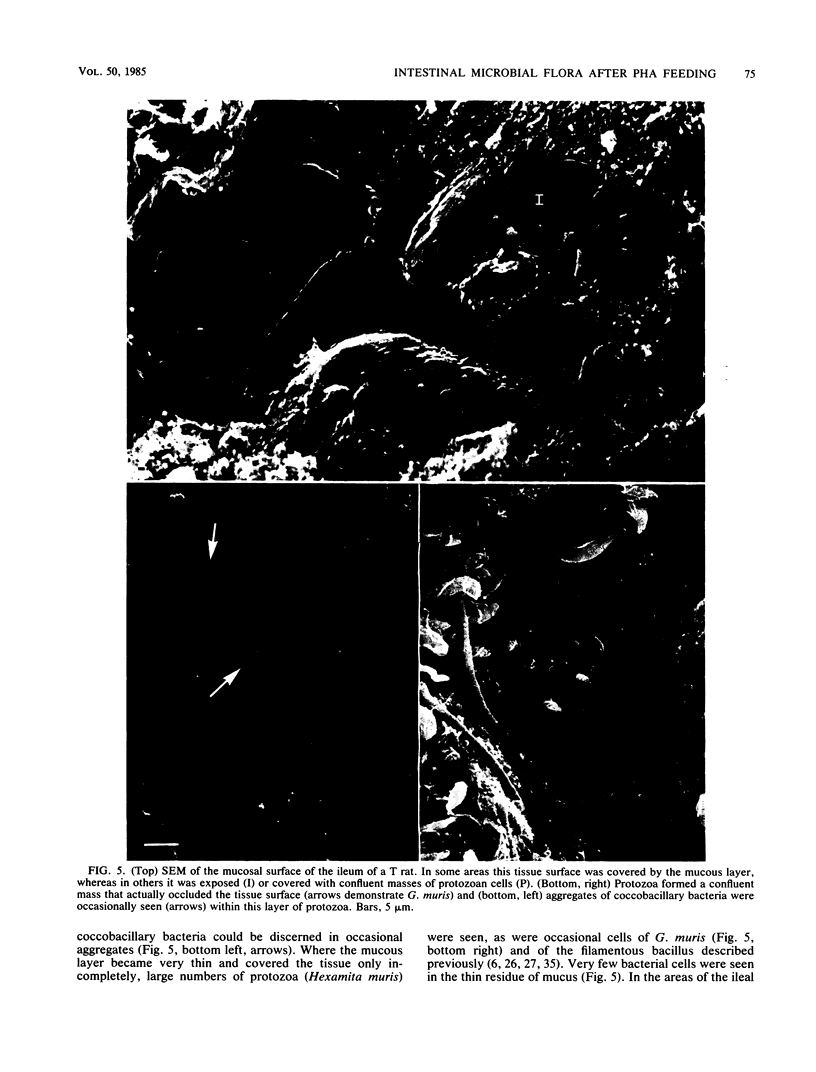
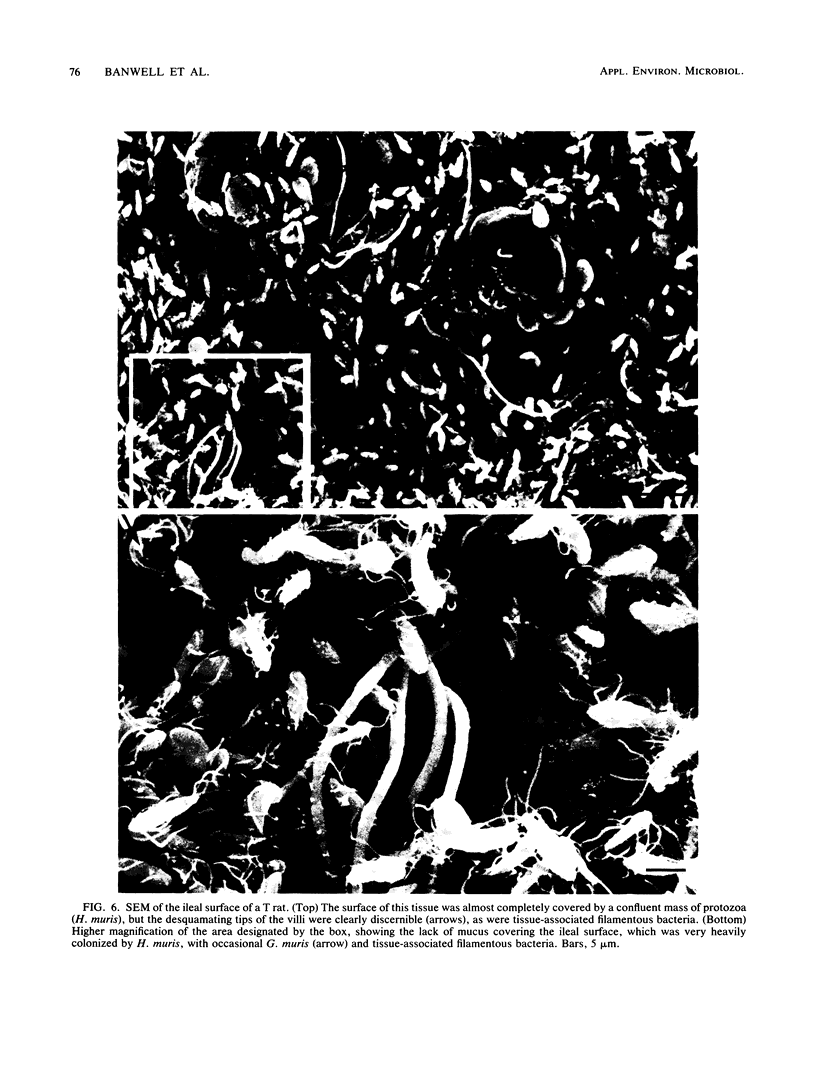
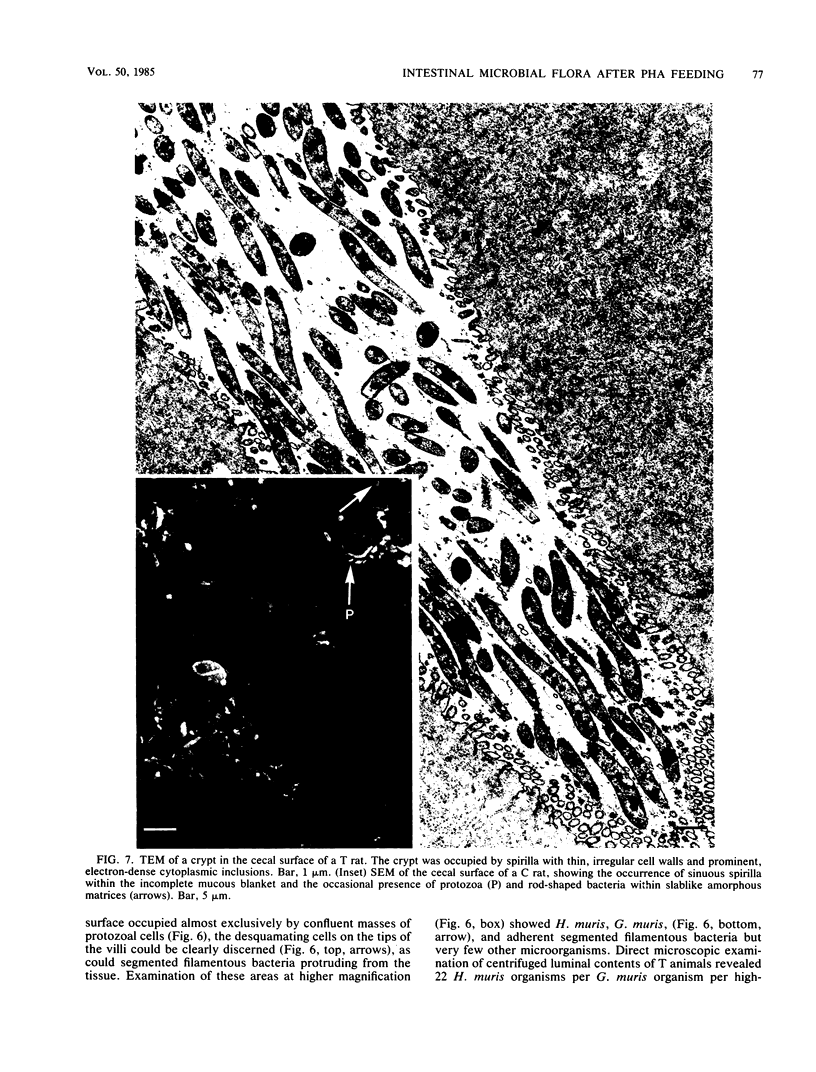
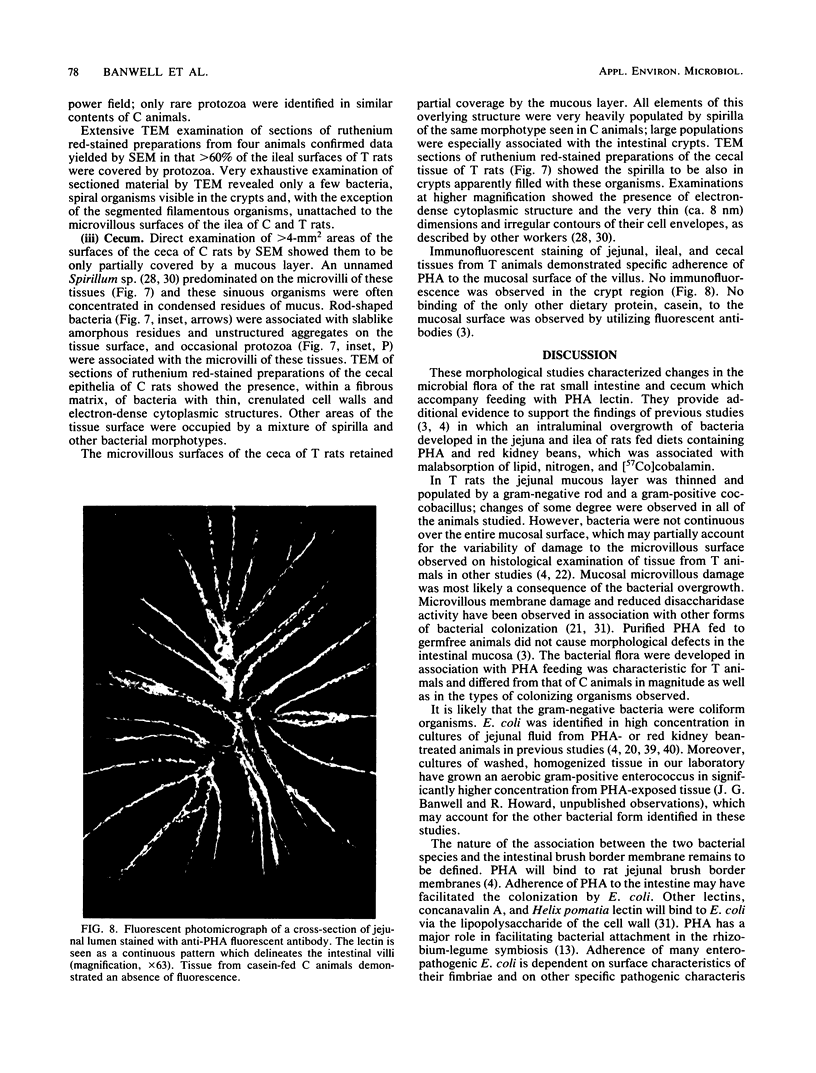
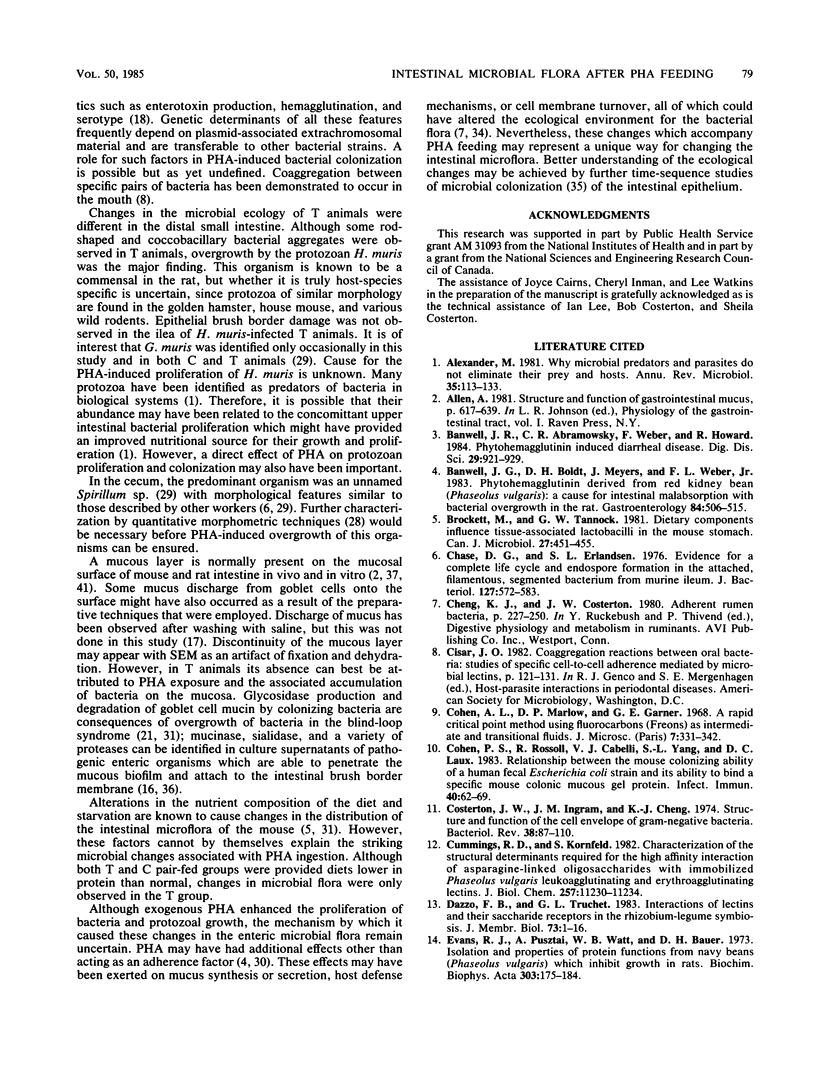
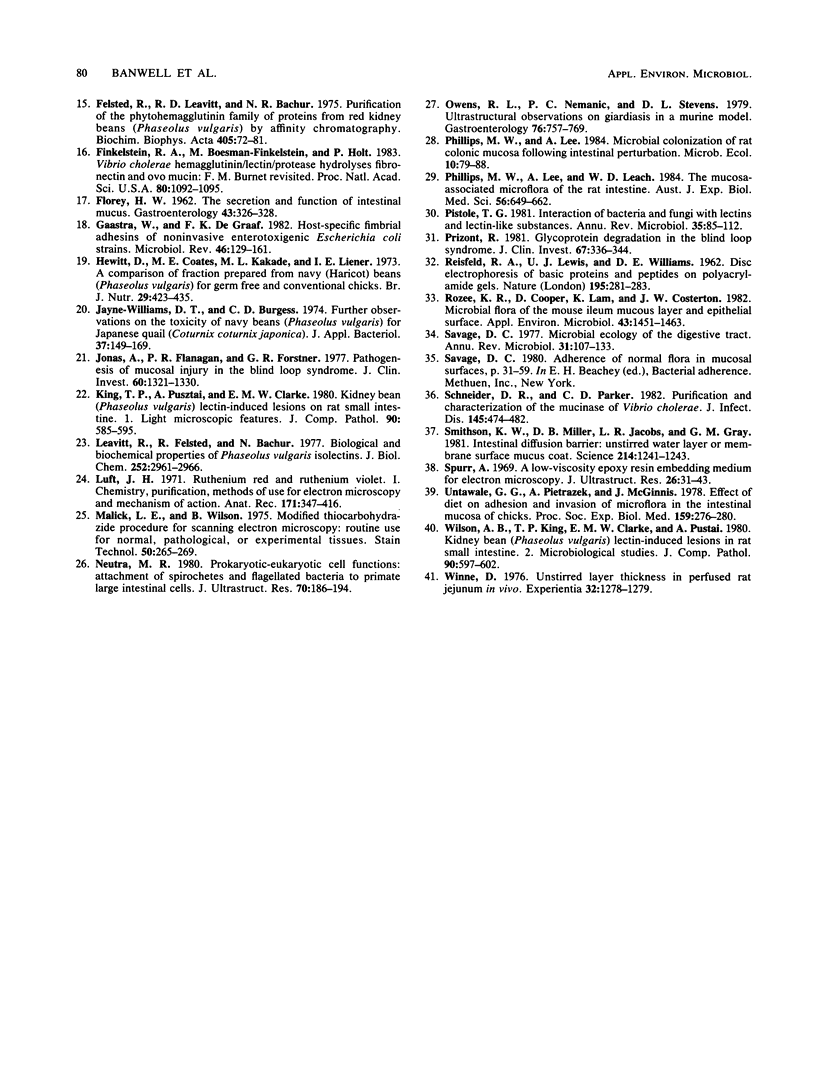
Images in this article
Selected References
These references are in PubMed. This may not be the complete list of references from this article.
- Alexander M. Why microbial predators and parasites do not eliminate their prey and hosts. Annu Rev Microbiol. 1981;35:113–133. doi: 10.1146/annurev.mi.35.100181.000553. [DOI] [PubMed] [Google Scholar]
- Banwell J. G., Abramowsky C. R., Weber F., Howard R., Boldt D. H. Phytohemagglutinin-induced diarrheal disease. Dig Dis Sci. 1984 Oct;29(10):921–929. doi: 10.1007/BF01312481. [DOI] [PubMed] [Google Scholar]
- Banwell J. G., Boldt D. H., Meyers J., Weber F. L., Jr Phytohemagglutinin derived from red kidney bean (Phaseolus vulgaris): a cause for intestinal malabsorption associated with bacterial overgrowth in the rat. Gastroenterology. 1983 Mar;84(3):506–515. [PubMed] [Google Scholar]
- Brockett M., Tannock G. W. Dietary components influence tissue-associated lactobacilli in the mouse stomach. Can J Microbiol. 1981 Apr;27(4):452–455. doi: 10.1139/m81-068. [DOI] [PubMed] [Google Scholar]
- Chase D. G., Erlandsen S. L. Evidence for a complex life cycle and endospore formation in the attached, filamentous, segmented bacterium from murine ileum. J Bacteriol. 1976 Jul;127(1):572–583. doi: 10.1128/jb.127.1.572-583.1976. [DOI] [PMC free article] [PubMed] [Google Scholar]
- Cohen P. S., Rossoll R., Cabelli V. J., Yang S. L., Laux D. C. Relationship between the mouse colonizing ability of a human fecal Escherichia coli strain and its ability to bind a specific mouse colonic mucous gel protein. Infect Immun. 1983 Apr;40(1):62–69. doi: 10.1128/iai.40.1.62-69.1983. [DOI] [PMC free article] [PubMed] [Google Scholar]
- Costerton J. W., Ingram J. M., Cheng K. J. Structure and function of the cell envelope of gram-negative bacteria. Bacteriol Rev. 1974 Mar;38(1):87–110. doi: 10.1128/br.38.1.87-110.1974. [DOI] [PMC free article] [PubMed] [Google Scholar]
- Cummings R. D., Kornfeld S. Characterization of the structural determinants required for the high affinity interaction of asparagine-linked oligosaccharides with immobilized Phaseolus vulgaris leukoagglutinating and erythroagglutinating lectins. J Biol Chem. 1982 Oct 10;257(19):11230–11234. [PubMed] [Google Scholar]
- Evans R. J., Pusztai A., Watt W. B., Bauer D. H. Isolation and properties of protein fractions from navy beans (Phaseolus vulgaris) which inhibit growth of rats. Biochim Biophys Acta. 1973 Mar 23;303(1):175–184. doi: 10.1016/0005-2795(73)90159-1. [DOI] [PubMed] [Google Scholar]
- FLOREY H. W. The secretion and function of intestinal mucus. Gastroenterology. 1962 Sep;43:326–329. [PubMed] [Google Scholar]
- Felsted R. L., Leavitt R. D., Bachur N. R. Purification of the phytohemagglutinin family of proteins from red kidney beans (Phaseolus vulgaris) by affinity chromatography. Biochim Biophys Acta. 1975 Sep 9;405(1):72–81. doi: 10.1016/0005-2795(75)90316-5. [DOI] [PubMed] [Google Scholar]
- Finkelstein R. A., Boesman-Finkelstein M., Holt P. Vibrio cholerae hemagglutinin/lectin/protease hydrolyzes fibronectin and ovomucin: F.M. Burnet revisited. Proc Natl Acad Sci U S A. 1983 Feb;80(4):1092–1095. doi: 10.1073/pnas.80.4.1092. [DOI] [PMC free article] [PubMed] [Google Scholar]
- Gaastra W., de Graaf F. K. Host-specific fimbrial adhesins of noninvasive enterotoxigenic Escherichia coli strains. Microbiol Rev. 1982 Jun;46(2):129–161. doi: 10.1128/mr.46.2.129-161.1982. [DOI] [PMC free article] [PubMed] [Google Scholar]
- Hewitt D., Coates M. E., Kakade M. L., Liener I. E. A comparison of fractions prepared from navy (haricot) beans (Phaseolus vulgaris L.) in diets for germ-free and convential chicks. Br J Nutr. 1973 May;29(3):423–435. doi: 10.1079/bjn19730118. [DOI] [PubMed] [Google Scholar]
- Jayne-Williams D. J., Burgess C. D. Further observations on the toxicity of navy beans (Phaseolus vulgaris) for Japaneses quail (Coturnix coturnix japonica). J Appl Bacteriol. 1974 Mar;37(1):149–169. doi: 10.1111/j.1365-2672.1974.tb00425.x. [DOI] [PubMed] [Google Scholar]
- Jonas A., Flanagan P. R., Forstner G. G. Pathogenesis of mucosal injury in the blind loop syndrome. Brush border enzyme activity and glycoprotein degradation. J Clin Invest. 1977 Dec;60(6):1321–1330. doi: 10.1172/JCI108891. [DOI] [PMC free article] [PubMed] [Google Scholar]
- King T. P., Pusztai A., Clarke E. M. Kidney bean (Phaseolus vulgaris) lectin-induced lesions in the small intestine: 1. Light microscope studies. J Comp Pathol. 1980 Oct;90(4):585–595. doi: 10.1016/0021-9975(80)90107-3. [DOI] [PubMed] [Google Scholar]
- Leavitt R. D., Felsted R. L., Bachur N. R. Biological and biochemical properties of Phaseolus vulgaris isolectins. J Biol Chem. 1977 May 10;252(9):2961–2966. [PubMed] [Google Scholar]
- Luft J. H. Ruthenium red and violet. I. Chemistry, purification, methods of use for electron microscopy and mechanism of action. Anat Rec. 1971 Nov;171(3):347–368. doi: 10.1002/ar.1091710302. [DOI] [PubMed] [Google Scholar]
- Malick L. E., Wilson R. B. Modified thiocarbohydrazide procedure for scanning electron microscopy: routine use for normal, pathological, or experimental tissues. Stain Technol. 1975 Jul;50(4):265–269. doi: 10.3109/10520297509117069. [DOI] [PubMed] [Google Scholar]
- Neutra M. R. Prokaryotic-eukaryotic cell junctions: attachment of spirochetes and flagellated bacteria to primate large intestinal cells. J Ultrastruct Res. 1980 Feb;70(2):186–203. doi: 10.1016/s0022-5320(80)80005-0. [DOI] [PubMed] [Google Scholar]
- Owen R. L., Nemanic P. C., Stevens D. P. Ultrastructural observations on giardiasis in a murine model. I. Intestinal distribution, attachment, and relationship to the immune system of Giardia muris. Gastroenterology. 1979 Apr;76(4):757–769. [PubMed] [Google Scholar]
- Phillips M., Lee A., Leach W. D. The mucosa-associated microflora of the rat intestine: a study of normal distribution and magnesium sulphate induced diarrhoea. Aust J Exp Biol Med Sci. 1978 Dec;56(6):649–662. doi: 10.1038/icb.1978.73. [DOI] [PubMed] [Google Scholar]
- Pistole T. G. Interaction of bacteria and fungi with lectins and lectin-like substances. Annu Rev Microbiol. 1981;35:85–112. doi: 10.1146/annurev.mi.35.100181.000505. [DOI] [PubMed] [Google Scholar]
- Prizont R. Glycoprotein degradation in the blind loop syndrome: identification of glycosidases in jejunal contents. J Clin Invest. 1981 Feb;67(2):336–344. doi: 10.1172/JCI110040. [DOI] [PMC free article] [PubMed] [Google Scholar]
- REISFELD R. A., LEWIS U. J., WILLIAMS D. E. Disk electrophoresis of basic proteins and peptides on polyacrylamide gels. Nature. 1962 Jul 21;195:281–283. doi: 10.1038/195281a0. [DOI] [PubMed] [Google Scholar]
- Rozee K. R., Cooper D., Lam K., Costerton J. W. Microbial flora of the mouse ileum mucous layer and epithelial surface. Appl Environ Microbiol. 1982 Jun;43(6):1451–1463. doi: 10.1128/aem.43.6.1451-1463.1982. [DOI] [PMC free article] [PubMed] [Google Scholar]
- Savage D. C. Microbial ecology of the gastrointestinal tract. Annu Rev Microbiol. 1977;31:107–133. doi: 10.1146/annurev.mi.31.100177.000543. [DOI] [PubMed] [Google Scholar]
- Schneider D. R., Parker C. D. Purification and characterization of the mucinase of Vibrio cholerae. J Infect Dis. 1982 Apr;145(4):474–482. doi: 10.1093/infdis/145.4.474. [DOI] [PubMed] [Google Scholar]
- Smithson K. W., Millar D. B., Jacobs L. R., Gray G. M. Intestinal diffusion barrier: unstirred water layer or membrane surface mucous coat? Science. 1981 Dec 11;214(4526):1241–1244. doi: 10.1126/science.7302593. [DOI] [PubMed] [Google Scholar]
- Spurr A. R. A low-viscosity epoxy resin embedding medium for electron microscopy. J Ultrastruct Res. 1969 Jan;26(1):31–43. doi: 10.1016/s0022-5320(69)90033-1. [DOI] [PubMed] [Google Scholar]
- Untawale G. G., Pietraszek A., McGinnis J. Effect of diet on adhesion and invasion of microflora in the intestinal mucosa of chicks. Proc Soc Exp Biol Med. 1978 Nov;159(2):276–280. doi: 10.3181/00379727-159-40331. [DOI] [PubMed] [Google Scholar]
- Wilson A. B., King T. P., Clarke E. M., Pusztai A. Kidney bean (Phaseolus vulgaris) lectin-induced lesions in rat small intestine: 2. Microbiological studies. J Comp Pathol. 1980 Oct;90(4):597–602. doi: 10.1016/0021-9975(80)90108-5. [DOI] [PubMed] [Google Scholar]
- Winne D. Unstirred layer thickness in perfused rat jejunum in vivo. Experientia. 1976 Oct 15;32(10):1278–1279. doi: 10.1007/BF01953092. [DOI] [PubMed] [Google Scholar]



